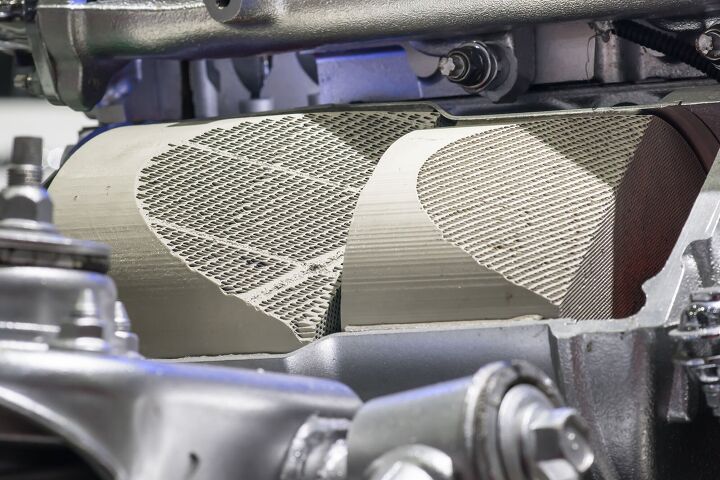What Are Catalytic Converters and Why Are They Being Stolen?

To a small group of people, the metal cylinder that interrupts the otherwise perfect circle of your exhaust pipe looks like a big ol’ bag of money. It’s the reason we’ve seen frequent coverage of catalytic converter theft over the last year.
A catalytic converter, or “cat,” in cool-car-guy-talk, is just that. These tubes of metal take the nasty stuff from your engine and turn it into less-than-nasty stuff by the time it leaves your tailpipe. While any sufficiently advanced technology is indistinguishable from witchcraft, we’re hopefully going to dispel that in favor of some knowledge, including how cats work, why they’re worth stealing (and why we’re hearing about it), and some steps you can take to prevent it from happening.
Let’s start with that first point. A catalytic converter is full of rare-earth metals like palladium, rhodium, and more. These metals are combined and laid in a honeycomb pattern inside the tube, which faces in the same direction as the flow of exhaust gasses. These metals react with exhaust gasses, chemically converting them to nitrogen, CO2, water, and oxygen. After being converted, your catalytic converter’s job is largely done. These new chemically converted gasses leave your car’s tailpipe. A cat (not the fluffy ones) at work is why you’ll often see small puddles of water under your tailpipes -- that and some other basic chemistry we needn’t broach now.
So, why would someone want to jack your car up into the air (sometimes in broad daylight) to steal a tube full of metal? Petty thefts like this one are what folks smarter than we call “crimes of opportunity.” Basically, it’s because taking your cat is easy. Due to its placement on cars, a catalytic converter is very easy to spot, in addition to being easy to access. Most can be removed with cheap power tools in a matter of seconds, especially if you have a taller vehicle and thieves don’t need to use a jack to crawl underneath your car.
Of course, we’re hearing about all this right now because of the pandemic and the resulting ripples that ran through our global economy and infrastructure. Suddenly, prices for metals like palladium and rhodium went up, at least in part because people were getting sick and boats were getting stuck in canals. The juice, so to speak, became worth the squeeze when prices rose, and folks decided it was worth ripping open a cat for its valuable metals. These would often be sold and smelted into something else entirely. That’s also why cats are expensive to replace once yours gets stolen. There’s no such thing as a working used catalytic converter, and they’re often vehicle-specific.
So, how do you stop the theft of your catalytic converter? Most solutions are deterrents, like the Catstrap. Comprised of hardened steel strips laid under a bright orange exterior, the Catstrap will repel most power tools. Plus, it has a heat-activated adhesive, which is perfect for making the material stick to your hot catalytic converter. It’s also reasonably priced. Another popular solution is a simple cage welded or strapped onto your exhaust system.
These are usually comprised of a set of steel cables attached to mounting points at either end of your catalytic converter. Their aim is much the same as the Catstrap, like the CatClamp (yes, the majority of these use some sort of cat-based name pun). The CatClamp adjusts between 1.75- and 3-inch diameters, so it’ll fit all but the most beefy of exhausts. Two versions are available: a steel and a stainless steel one. CatClamp claims the cables are “uncuttable,” and the standard and Maxx models both feature a warranty -- a year or a lifetime one, respectively.
Both of these ought to keep most thieves from running off with your foot-long metal money bag, but there’s no panacea here. Being mindful of where you park and for how long is important too, and until prices of these exotic metals further stabilize, being preventative is the best cure.

Chase is an automotive journalist with years of experience in the industry. He writes for outlets like Edmunds and AutoGuide, among many others. When not writing, Chase is in front of the camera over at The Overrun, his YouTube channel run alongside his friend and co-host Jobe Teehan. If he's not writing reviews of the latest in cars or producing industry coverage, Chase is at home in the driver's seat of his own (usually German) sports cars.
More by Chase Bierenkoven

































Comments
Join the conversation
Thieves don't have to jack up your car unless it's really low to the ground. They just slide in underneath, and in less than 90 seconds, have sliced the pipes attached to the cat (often doing great damage), slide back out, and run for their car or truck. They like to do it to cars parked in driveways between 1AM and 5 or 6AM when there are few cops out and about and the car owners are asleep, casing out the area earlier in the day.
The real question; why do car makers make it so easy? Reminds me of Kia and Hyundai, which built a bunch of cars that are super easy to steel.